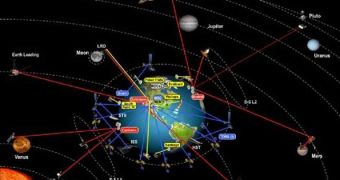Even with all the high-tech instruments aboard all of NASA's spacecrafts, rovers and landers, there is always something that is dragging down communications, and that is the aging network that the space agency uses to stay in contact with its space exploration vehicles. Transfer rates between Earth and missions on or around Mars, Saturn, Venus and Pluto are painfully low, and US experts are looking at ways of remedying that. One possible solution would be to merge the agency's three aged space communication networks into a single, highly efficient one, Space reports.
This is absolutely necessary groundwork, if NASA is to engage in more complex missions, such as establishing permanent bases on Mars or the Moon. However, the agency is at the end of its rope in financial terms, and so it has to be able to upgrade its capabilities considerably without actually paying a single cent to do it. The goal is to boost transfer rates from a few megabytes per second to as much as 600 megabytes per second. According to analysts, this would enable all of current and future science missions to maximize their data output, and transfer data at 50 times the rate they have today.
“Imagine what you can accomplish with a single mission instead of several spacecraft flying over several years to collect the data,” explains the NASA Space Communications and Navigation deputy associate administrator, Badri Younes. He reveals that current transfer rates pose challenges to mission controllers even when uploading or downloading files the size of an mp3 song. With the upgrades, the agency could become able to handle files the size of an HD YouTube video both ways, in a more reduced time frame. After spending ten years at the Goddard Space Flight Center (GSFC), Younes was hired by the DoD, and again by NASA to revolutionize its communications grid.
The most difficult task ahead is improving the data systems – which were last updated at the start of the 1990s – while maintaining contact with, and control over, existing missions, such as the Martian rovers and orbiters, and the International Space Station (ISS). “It's like driving a 1960s Chevy that's beat up and losing paint while going at 90 mph, and being pushed to convert that into a Lamborghini while driving 90 mph without losing a beat,” Younes adds. The agency's Space Network (SN), Near-earth Network (NEN), and Deep Space Network (DSN) need further support, and new satellite additions to it would be more than welcomed.

 14 DAY TRIAL //
14 DAY TRIAL //